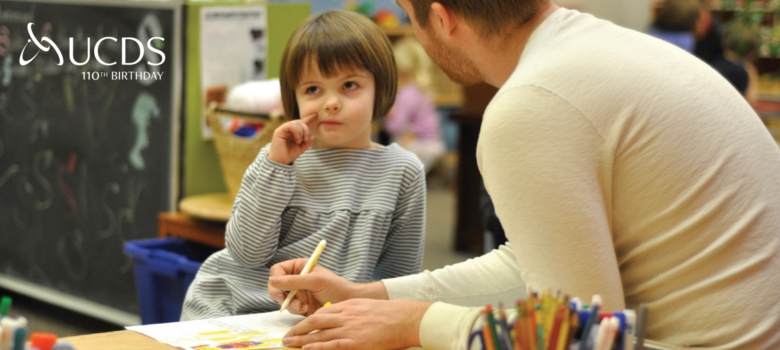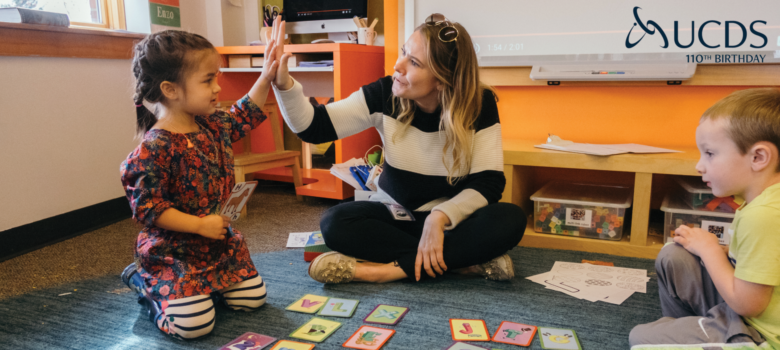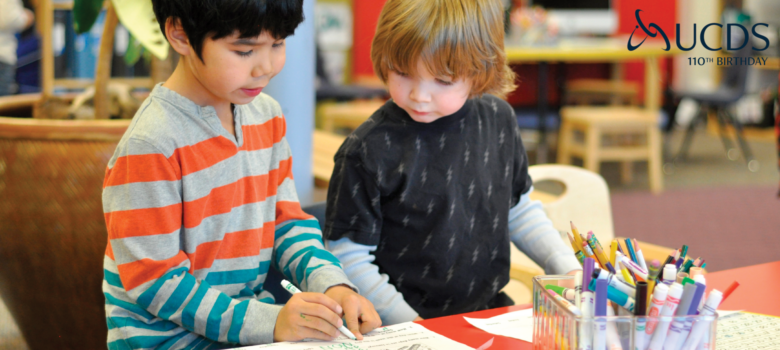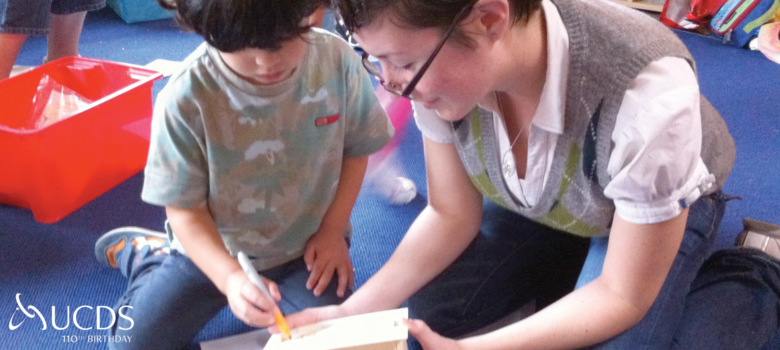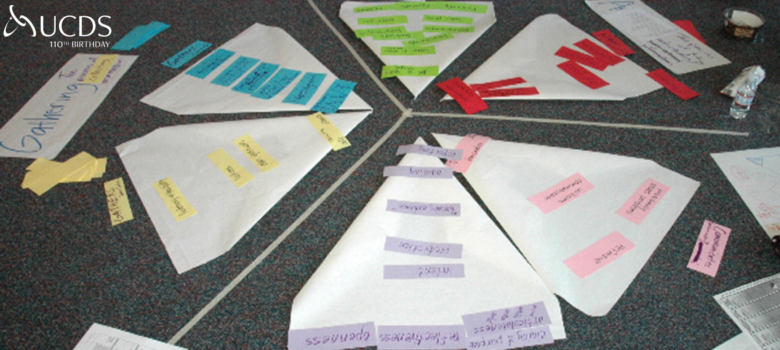UCDS is having a birthday! As we celebrate our 110th year, we are rolling back the clock and re-sharing six highlights of an innovative school: Culture of Inquiry, Sticky Curriculum, Authentic Assessment, Teacher Mentorship through Collaboration, Coaching Independence, and Being Brave. Over the next six weeks, we’ll revisit some in-depth reflections from UCDS Spark Magazine. You can also read full archived content of Spark Magazine at: https://issuu.com/ucds
What if the Answer is Learning to Ask Questions?
by Paula Smith
UCDS Spark
Issue #14, Winter 2014
Crayton Turner was supposed to be teaching me American History from one of the textbooks that were piled in the back corner of the classroom. He didn’t even pass them out. Instead, Mr. Turner announced to my class that American History was a recent piece of a much bigger picture and that we were going to back up a bit to cover everything that came before the last several hundred years. We started with the formation of planet earth, and we worked our way forward. Mr. Turner’s desk was piled with dozens of books that we sampled as we surveyed history through the eons. We took turns reading aloud, engaged in countless discussions and were responsible for research that we each took turns presenting to the class. Mr. Turner challenged us to ask why events unfolded the way they did and to provide evidence that would support our theories.
In truth, I do not remember many of the facts I learned that year, but I did learn how to place information in context; to think about the way one event, or one idea, shaped what happened next; and to question the accepted version of what happened in the past. But most importantly, I got to spend time with an adult who loved to read, to learn, to think, to hypothesize, an adult who inspired me to want to be as knowledgeable, passionate and excited about learning, ideas and history as he was. What I remember about that class 40 years ago was the way that Mr. Turner taught me to ask questions.
While the way we live, work and learn outside of school is dramatically different than it was when a man first walked on the moon, the way we learn in school hasn’t changed all that much. Although there are several trends that now provide an opportunity to change the way children learn in schools (such as recently adopted Common Core Standards, integrated technology and access to charter schools), for a majority of teachers with no control over curriculum, instructional methods or assessment tools, the professional culture is much the same. It was clear back then that Mr. Turner’s classroom was different than any other in my high school. He simply shut his door to the hallway and used his own collection of books to create the learning experience that he envisioned for us. It took several years before the administration realized that he wasn’t sticking to the script, and he was ultimately terminated by the school district.
Today, teachers across the country can face a similar fate if they vary from the district curriculum and instructional guidelines. One difference, however, is the accountability that is now in place in the form of standardized tests at several points in the school year. Teachers must pace their instruction carefully, mindful of performance outcomes that will be posted on the district website. The pressure to cover content leaves little time to explore a big idea and little opportunity to ask questions that are not part of the lesson plan. As a result, students may learn to identify the pre-determined “right answers” without mastering the understanding and skill to derive the solution to a real problem. There frequently is no time for students to generate, research, analyze, debate and evolve questions that they care about. In stark contrast to the drive and curiosity that fuels learning outside of school, students learning in a traditional classroom have few opportunities to consider questions that would cause them to fall in love with learning.
It was really quite by accident that UCDS came to organize around questions. As a lab school on the University of Washington (UW) campus from 1911 to 1981, we spent our first 70 years serving preschool and kindergarten students. During that time, large curriculum companies had not yet identified early childhood classrooms as a major profit center. Our teachers needed to adapt or create the curriculum that we used with our young students and also needed to evaluate how well it worked. From the beginning it was a collaborative effort. Teachers worked together to design the curriculum, to implement it in the classrooms, and together discussed how well it had worked before designing what came next. We needed to ask ourselves:
What should we be asking children to do and why? What do the children know and care about?
How well did it work for each student, and why or why not? How do we know, and what is our evidence?
Out of necessity, our teachers developed a professional culture of inquiry. In other words, we were able to create a culture of asking questions by asking questions and by making time to answer them. It is this culture that we took with us when we left the UW campus to establish an independent elementary school. And, it is this culture of inquiry that is the central organizing principle of our school today.
Walking through UCDS, visitors notice immediately that children are highly engaged and working independently. Students lean forward, unaware that we have entered the classroom. The teacher is not immediately visible, and we find her sitting at a table in conversation with a student. In fact, our teachers don’t spend much time standing at the front of the room as we don’t “teach the answers” in advance. Instead, a new project is presented by asking the children questions. What is important about this project? What do we know already? What will we need to figure out? What will we have to consider when we approach this problem? The air in the room is electric as the children dig in. They are encouraged to use the core knowledge/ strategies they know, to ask questions when they get stuck, and are encouraged to share their approach with classmates. The teacher moves about the room checking in with individual students, asking questions, making observations and offering tips. Practically speaking, these coaching conversations make it possible to assess a child’s level of understanding while they are working, and our teachers will use what they learn to design what comes next.
What is not as obvious to visitors is that our work culture for teachers resembles the work culture for our students, and as a result, both teachers and students are constantly learning. Later on as teachers sit together to plan the next lesson, they spend a great deal of time building the questions they will use to introduce the next concept/ project and specific questions to ensure that every child gets a stretch. The discussion is lively as they review any surprises from the previous week and begin to brainstorm ways to build on what the children have learned and are excited to explore further. There are always numerous ideas about how we might proceed and listening to this conversation, one would notice a central feature of our culture: it is expected that we sometimes disagree.
This way of using questions to surface and iterate ideas is not all that different from the process used by a design team in the business world. And as a result, not only is our teaching plan better than each member of the team could achieve on their own, but also, every member of the team develops greater skill as a creative problem solver, communicator and collaborator. It is gratifying to be able to add value in a generative work session and to learn from others. And in contrast to a set work plan handed down from above, everyone has contributed and owns the outcome. As the team matures, the level of creativity increases. Working in this way, both our teachers and our students develop the resourcefulness to learn independently anywhere. Perhaps more importantly, they love their work.
At UCDS, we believe that gaining confidence in one’s own learning capacity is at the heart of education. As educators in a mission-driven independent school, our teachers have the opportunity to build a culture of inquiry and to work intentionally to achieve this goal. Our teachers spend less time talking and telling, and more time listening and observing students. Our students spend less time listening and observing the teacher, and more time trying to apply and to share what they have learned. Like my experience in Mr. Turner’s class so many years ago, our students not only learn to provide the right answers, but also to ask the questions that lead to deeper understanding. In doing so, we increase the capacity to learn as well as achieve. As education shifts into the 21st century, we need classrooms like Mr. Turners that engage and inspire. How to achieve this? Let’s ask the teachers and students.

